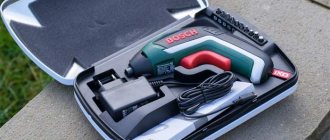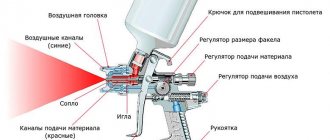If a fault occurs in the electrical wiring, calling a specialist is not always advisable, because the reason may be quite simple. Some breakdowns can be repaired yourself by using a device such as an indicator screwdriver. A useful device for everyday use, it is reliable and easy to use, and can replace expensive and complex tools. To check electricity, you do not have to be an electrician; with minimal knowledge in the field of electrical supply, you can use a screwdriver to determine the “phase” and “zero” wires.
Types of devices
The main structural elements of the tools are a narrow flat blade (“minus” screwdriver) and a light or sound indicator. The remaining parts serve as additional components. For example, the housing connects, hides and protects parts. Batteries provide the power necessary for the operation of the indication or electronic display. Let's take a closer look at the device, operating principle and how to use this or that tester screwdriver.
Components of a universal device Source instrumentgid.ru
Neon lamp probe
The design of such an indicator screwdriver is considered the simplest in its group. It is intended to solve only one problem - determining the presence or absence of voltage in the conductor. In this case, operation is possible only if the threshold of 60-70 Volts is exceeded. Rarely, screwdrivers are used for a 12-36 V network.
Structurally, the electrical probe consists of a metal tip and a body. Inside the handle there is a neon light bulb and a microcircuit with a transistor and a resistor. Additionally, a spring and a closing plate can be installed on the end of the handle.
The principle of operation of the device without a contact pad is simple. Here the indication is triggered after the tip touches a serviceable section of the low-voltage circuit. The plate in other probes serves to supply current to the light bulb. Here you just need to touch the sensor with your finger. It is safe for a person to be the contactor of the second contact of the indicator in the chain, since the resistor has a resistance value in the range of 0.5-1 MOhm.
Tester with batteries
This device is equipped with a field-effect or composite transistor (usually bipolar), LED indication, and a contact plate.
Tester with batteries Source amazon.com
The latter is needed to determine the functionality of the screwdriver. A person must touch the tip and the end of the handle, then the light will light up (if the tester is in good condition).
There is also a slot for placing 2-3 coin-type batteries. If the indication does not work during the test, then they need to be replaced. To do this, simply unscrew the end part of the handle.
The functionality of the LED device includes solving the following problems:
- Determination of phase. A similar action is typical for any type of indicator screwdriver. However, with a battery-powered sample, wires in an insulating winding can be examined with the same efficiency.
- Definition of zero. A simple probe does not distinguish an open circuit from a neutral conductor - the neon light does not light in both cases. A tester with batteries can replace a multimeter, as it is able to detect and show the integrity of the cable.
- Calling. This implies an inspection of fuses, heating elements, and incandescent lamps for integrity. It is also possible to detect a break in the winding of a transformer or other electrical device or equipment.
Checking an incandescent lamp Source yandex.net
- Breakdown check. This action applies to diodes, including searching for anodes with cathodes.
- Search for cable. This is especially true when repairing walls with hidden wiring. But a particular device has a limitation in the depth of the desired line. The indicator does not exceed 1.5 cm.
Inexpensive indicator screwdrivers for their cost allow you to solve quite a lot of problems. However, there is one important drawback - small batteries have a low charge. To prevent the batteries from running out longer, experts recommend that the protruding part of the tip be insulated during passive storage of the device. For example, you can take a PVC tube (cambric) of the required diameter and cut a cap of sufficient length from it.
See also: Catalog of companies that specialize in electrical work of any complexity
Non-contact device
The tester, similar to the previous version, runs on batteries. Only here batteries are used with higher power (for example, type 23A at 12 V). Also, a distinctive feature is not a metal tip, but a short plastic tip. The voltage indication is supplemented by an audible signal.
Contactless device Source 5×86.ru
Such electrical receivers are characterized by high sensitivity. There are samples on which adjustment is permissible in order to test the network with different voltages. Thanks to the built-in sensors, work can be performed without direct contact of the tip with the conductor or its insulation.
In addition to searching for wires connected to the network and determining voltage (or lack thereof), a non-contact screwdriver-voltage indicator can find hidden metal elements. This could be a disconnected cable or reinforcement in a reinforced concrete structure. Such an error is an unjustified addition. Therefore, it is better to entrust the search for wiring to other devices.
Universal device
The combined type of indicator screwdriver combines a light and sound indicator, a metal tip, and batteries. This also applies to the functional part. Here you can perform work using the contact method and without touching the conductor or its insulation. You can check the integrity and connection of the cable, determine polarity, look for breaks and short circuits in both direct and alternating current conditions.
Universal screwdriver-indicator Source zubr-vrn.ru
Electronic devices
Due to their wide functionality, such electrical probes are conventionally called a miniature version of a multimeter. But you should not rely on the device’s readings due to its low accuracy. The indication here can be LED (there are 2 or more of them, different colors) or the information is displayed on a liquid crystal display. The verification method is contact and non-contact.
Scope of application of indicator screwdrivers
The voltage indicator is used for the following purposes:
- Determination of phase, neutral wire;
- Determining the polarity of rechargeable batteries and batteries;
- Search for hidden (immured) wiring in the wall;
- Search for an open circuit;
- Checking the performance of heating elements, incandescent lamps, diodes and other radio components.
In addition, using digital models of modern devices, you can determine the voltage value and the location of the positive and negative electrodes on the diode.
Criteria for selecting an electrical probe
Experts recommend equipping your home workshop (toolkit) with a simple contact screwdriver-indicator with an LED. This is enough to detect voltage or determine the integrity of the conductor, to find its location in the thickness of the wall. Samples with broad functionality are distinguished by more thorough instructions for the user, which requires constant practice to memorize.
The main selection criteria look like this:
- Voltage . For a single-phase network, the limit values can be 70-250 or 100-250 V, for a three-phase network - up to 400 V. If you have to work with a low-voltage network, then 12-24-36 V are considered.
Tester for working with networks up to 250 V Source zubr-vrn.ru
- Tip length . The size can be 12 or 18-19 mm. That is, it is either easier to work in hard-to-reach places (oven) or when the research object is located at a distance (wire, contacts).
Before paying, it is important to check the device for serviceability. You also need to find out the type of batteries used; it is better to purchase spare ones in advance. Among other things, you need to find out in advance how to use a particular indicator screwdriver.
Differences and functionality
The first thing I would like to pay attention to is the blade of the screwdriver. Most of the models are not designed for full-fledged work on tightening and unscrewing screws.
This is their additional opportunity. So for such work, always use regular screwdrivers with hardened blades or appropriate bits, and not indicator versions.
The most useful function of this model is the LED glow when you simultaneously touch the tip and the contact at the opposite end with your hands.
This is actually a continuity check indicator. How it can be used in everyday life will be discussed below.
You can also use this screwdriver to:
- look for hidden wiring if it is not buried deep in a layer of plaster
Be careful, if the indicator lights up all over the wall, you may have a leak or short circuit somewhere.
- find out whether a wire is live or not without removing the insulation from it
- find a break in the wire
- and of course, the screwdriver copes well with its direct responsibility - determining the phase
Rules for using testers
It is permissible to work only with a working tool. This doesn't just apply to batteries. It is important that there is no damage to the case. For safe use, experts recommend discarding the insulating tape and replacing the screwdriver with a new one.
As for the network, it needs to be de-energized. Even after a power outage, exposed areas of wiring can only be touched with a testing tool. Moisture in any form must be excluded to eliminate the risk of electric shock.
Checking the network with the machines turned off Source brigadir-info.ru
When checking the electrical wiring, do not touch the metal tip. A voltage with parameters that are characteristic of the network under study passes through it. The body of the pen is made of plastic that can protect a person from electric shock. Otherwise, the manufacturer writes in the instructions how to use the indicator screwdriver. Let's take a closer look at these recommendations.
Checking the serviceability of the tool
In addition to identifying external damage, you need to know how to check the indicator screwdriver for functionality. To do this, just insert the tip into each socket of a known working socket. A working device turns on the indication during contact with the phase.
How to operate different devices
A simple device needs to be applied with a tip to one of the conductors. If there is a contact plate, then you need to touch it with your finger. This is where the work ends, there are no other instructions.
How to use an indicator screwdriver with an LED - the rules are similar to the simplest tool for a contact sample. Only the contact plate is touched to check the serviceability of the tool.
Checking the indicator screwdriver for functionality Source eltctricon.ru
Non-contact testers do not provide for closing the internal circuit. Here the indication is triggered at a distance from the network if there is voltage in a specific area. However, the diode can also light up at an open circuit, which is important to consider during testing. But you can work with low-voltage systems.
Universal testers are a little more complicated. There is a contact plate and a light indication that works when the internal circuit is closed. In addition, there may be a built-in toggle switch for setting one or another operating mode. The marking implies the following:
- O. _ Network testing is performed using the principle of a simple screwdriver with a contact pad.
- L. _ The operating principle is identical to a contactless battery-powered device.
- H. _ High sensitivity mode. You can work with a low response threshold, which helps detect hidden wiring.
Device with a toggle switch for setting the operating mode Source yandex.net
Checking the grounding of household appliances
Washing machines, microwave ovens, refrigeration units - for safe operation they must be grounded. To verify this, touch the probe to the body of switched household appliance. There is no grounding if the LED lights up.
The light is on - there is no grounding
How to find wiring under plaster?
There is a separate article about this on Domovushkin.ru, where all possible methods are discussed. Here I’ll just note that a simple screwdriver is not suitable for searching. Need a universal or active one. The one that lights up when you press it at both ends. And success is not guaranteed if the wires are hidden deep or there are fittings in the wall.
How to proceed:
- Grasp the dipstick.
- Direct the opposite part towards the wall.
- Drive to the location where the cable is supposed to be located.
A glowing diode will indicate the presence of a live cable if it is not buried too deeply.
How to detect current leakage?
If the insulation is broken or a breakdown occurs, a leak occurs on the metal casing of household appliances. To protect yourself from damage, use an indicator screwdriver.
Carefully touch the surface of the unit when it is turned on. If the LED lights up even a little, this is a clear sign of a leak. You need to find insulation damage and check the grounding.
Briefly about the main thing
An indicator screwdriver is a device for detecting voltage in the network.
Depending on the modifications of the probes, you can additionally search for wires in walls, determine polarity, and detect open circuits or short circuits.
There are contact and non-contact devices, with neon or diode indication. There are samples with sensitivity settings and a digital display.
The user instructions include a preliminary check of the serviceability of the tool and how to operate a specific model.
Ratings 0
Rules for using voltage indicators
When working with this kind of tool, there are a number of rules that you need to know in order to do everything correctly.
Here you need to adhere to the following recommendations:
- compliance with the rules of safe work with electrical networks. This means that all manipulations with the indicator screwdriver should be carried out with the package switches turned off;
Switches turned off in the electrical panel.
- remember that electric current always flows through a conductor along the path of least resistance (from plus to minus);
Note! Any electrical appliance will function only if its phase/plus goes through the circuit to the neutral/negative wire of the network.
- Such an indicator meter of any type is not suitable for assessing complex electrical appliances. With its help, you can check the serviceability of electrical circuits of devices;
- in houses and apartments there is a standard network with a purity of 50Hz and a voltage of 220V;
- When working with such a screwdriver, you need to know that the (+) phase always receives voltage, the zero leads to the transformer (-), and the third wire is grounding (for example, in a socket).
When using a signal screwdriver in various works, be sure to adhere to the above rules. Otherwise, you may get the completely opposite result.
Characteristics
| Brand | Stayer |
| Weight | 0.06 kg |
Delivery in Moscow:
The cost of delivery within the Moscow Ring Road, with an order amount of 2000 rubles or more , is 350 rubles. The cost of delivery within the Moscow Ring Road, with an order amount of less than 2000 rubles , is 700 rubles.
Pickup cost: free .
For pickup, orders worth less than 2000 rubles must be paid in advance at 100%!
Delivery within the Moscow region up to 20 km:
30 rub./km
The cost of delivery of large-sized cargo is negotiated with the manager in each specific case.
Delivery across Russia:
Any shopping center present in your region. The cost of delivery to TK is 300 rubles. We prefer to work with the following shopping centers (established shipping process, discounts):
Payment:
Payment for your order is carried out in the following ways:
- Cash to the courier upon receipt. (Only in Moscow and Moscow Region)
- By bank card upon receipt of the order at the pick-up point.
- Cashless payment against an issued invoice for legal entities.
- By cashless payment against an issued invoice for individuals.
- Payment from a bank card via PayAnyWay
- For pickup, orders worth less than 2000 rubles must be paid in advance at 100%!
The simplest tool with a neon light bulb
The main function of this device is the voltage being tested, that is, the presence or absence of a phase. Because of this, the device received a different name and is known as an electrical probe.
The device of such an indicator screwdriver consists of a probe, a 1 MΩ resistor, a neon light bulb, a spring and a contact button located at the end of the handle.
The tool works as follows:
- When the tip touches a conductor, an electric current from its surface comes into contact with it.
- Further along the chain, through a limiting resistor, the current flows to the neon light bulb.
- After pressing the button on the handle, the second contact of the circuit closes. The human body has capacity and resistance, which become elements of a common circuit.
- If there is voltage and a closed circuit, the neon light will begin to glow.
The current flowing through the screwdriver is not dangerous to humans, since it is limited by the resistance of the resistor.
The disadvantage of this tool is the high level of indication, starting at 60 volts. At lower voltages, such a screwdriver becomes useless. In addition, it does not allow identifying a wire break, but only determines the very fact of the presence of a phase.











